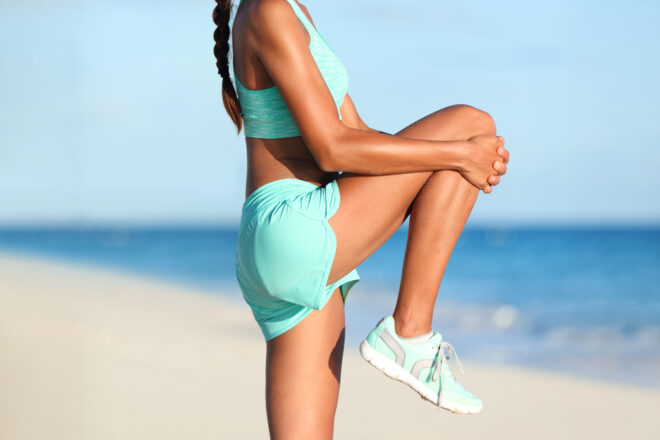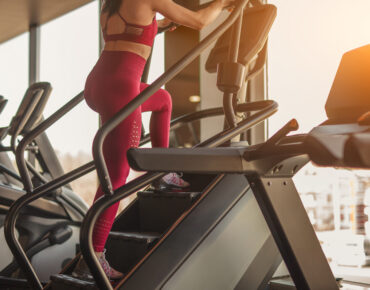Running a lot will make your muscles stronger and help you build stamina and endurance. But any type of running won’t necessarily tone your legs. To burn leg fat and replace it with muscle, runners need to do leg strength exercises.
Before we look at workouts you can try, let’s understand what happens to your body when you run and how running changes your legs.
In This Article:
What Running Does to Your Body
You may have heard funny anecdotes about a runner’s knee, tummy problems, black toenails, and the other side effects of running. But what about the benefits of running?
A 2014 study on 55,137 adults found that during a mean follow-up of 15 years, runners had a 45% lower cardiovascular mortality risk. The study also found that leisure-time runners had a 30% lower all-cause mortality risk and lived on average 3 years more. The study concluded that even 5–10 minutes of running a day at slow speeds significantly reduces mortality risk.
Recreational running has also been associated with improved circulation, higher oxygen intake, and better lung function.
When you run, it’s your quads and hamstring muscles that work the most. Your muscles and joints withstand impacts of up to 5 times your body weight. As a result, running makes your legs and hips leaner. It gives your legs a toned effect without defining them as strongly as, say, dancing.
The same is true when comparing cyclists’ legs to runners’ legs. Because cyclists’ legs can not endure the same impact force as runners’ legs, they seem more ripped. The fact that cyclists always contract their legs amplifies this impact. Runners only contract them when they strike the ground.
Your physique as a runner depends on what type of running you do. If you focus on long-distance running, you focus on stamina and endurance. That means you’ll be more likely to burn muscle, leading to leaner, skinnier legs. As a long-distance runner, being light is an advantage.
If you focus on sprinting, however, you’ll naturally develop a bulkier body. Your muscles will adapt to generating the power you need to run as fast as possible over short distances. This accounts for the noticeable difference in physique between marathon runners and sprinters.
Tip: To burn fat when running, you want to run short distances at a regular pace several times a week. You also need to take in fewer calories than you burn.
Leg Strength Workouts for Runners
Does running tone your legs fast? If you don’t see results right away, you may want to up your weekly mileage. But do it safely. Remember the 10% rule: don’t increase your mileage by more than 10% from one week to the next.
How you run also matters. If you land on the balls of your feet using a forefoot strike, you’ll work mostly your quads and calves.
If you heel strike, you’ll work your hamstrings and shin muscles more. Changing footstrike patterns and stride length could help you develop different muscles groups.
And remember: mental training is part of the effort to get runner’s legs, and it calls for patience and perseverance.
You also want to incorporate strength training into your routine, including bodyweight exercises. First, though, start with leg strength exercises.
Squats
Add squats to your workouts to work out your glutes, quads, calves, and hamstrings. You can do them indoors or outdoors.
1. Stand with feet a bit wider than hip-width apart.
2. Squat down with your hips back and feet centered.
3. Move your back up to the standing position.
Reps and sets: Start with 3 sets of 12 reps each.
Back squat
Got a barbell at home? Try back squats too. They work mainly your glutes, hamstrings, and lower back but also engage the quads.
1. Hold a barbell behind your head and rest it on your trapezius muscles.
2. Stand with the feet shoulder-width apart.
3. Hold your chest up.
4. Bend your knees and lower your backside, pushing the knees out.
5. Pause when your thighs are parallel to the ground.
6. Stand back up.
Reps and sets: Start with 3 sets of 12 reps each.
Tip: You can use a bar without barbells to get the movement right before adding weight.
Single leg squats
This exercise works all the major leg muscles and improves your balance.
1. Stand on a leg with a slightly bent knee.
2. Lift the other leg and extend it in front.
3. Lower your support leg into a squat while keeping your back straight.
4. Repeat with the other leg.
Reps and sets: Start with 2 sets of 12 reps each.
Note: Getting used to this exercise may take a bit of time, so move slowly while maintaining balance.
Reverse lunges
Ever tried reverse lunges? They work your hamstrings and glutes and can add variety to your workouts.
1. Stand with feet at shoulder-width and hands on the hips.
2. Take a step back. Your ankle should be under your front knee.
3. Lower your hips into a squat until your front thigh is parallel with the ground.
4. Return to the starting position and repeat with the other leg.
Reps and sets: Do 3 sets of 12 reps each.
Walking lunges
Walking lunges target your quads, glutes, and hamstrings. Build them into your workout to exercise these muscles more often.
1. Stand with your feet at shoulder-width and hands on the hips.
2. Step forward with your leg and put the weight into the heel.
3. Bend the knee and pause once it’s parallel to the floor.
4. Move the other foot forward, repeating the movement.
5. Alternate legs and walk forward as you lunge.
Reps and sets: Do 3 sets of 12 reps each.
Box jumps
Box jumps build up power in your glutes and give your quads a good workout too. Plus, they’re fun. You’ll need a box or steps for this one.
1. Stand with feet at shoulder-width.
2. Bend your knees and move your arms and hips back into a partial squat.
3. Swing arms forward and push into your legs to jump on the steps or box. Make sure to land in a partial squat.
4. Maintain the squat position for a moment and then step back on the floor.
Reps and sets: Start with 2 sets of 10 reps each.
Note: Step back gently rather than jumping down from the steps or box, which puts extra strain on your muscles and tendons.
Single leg deadlift
A popular leg workout for runners, the single leg deadlift will make your hamstrings and back stronger.
1. Stand tall and straight.
2. Lift one foot off the floor.
3. Hinge your body at the hip to tilt forward.
4. Lower your chest toward the floor and bring your foot up behind you. Your body, from the head to the ankle, should be straight.
5. Bend the knee of your standing foot slightly.
6. Pause for a moment after completing the movement and then straighten up.
7. Do your reps and then switch legs.
Reps and sets: Start with 2 sets of 12 reps each.
Other Exercises to Tone Your Legs
Next, here are some of the most effective exercises for lean legs and calves for runners. You can incorporate these into your weekly running workouts whether you’re a beginner or a seasoned runner.
The difference is how intense you make them. If you’re at the beginning of your running journey, don’t push yourself too hard too soon.
Read on how to do them to find out how to get runners’ legs. Apart from running regularly, of course. All in all, they are some of the best leg workouts for runners.
Skipping rope
Simple, short, and effective, skipping calls for explosive movements that can boost your leg strength. Ten minutes of skipping can burn around 140 calories.
It’s best to skip rope on an exercise mat or grass rather than on a hard surface which puts extra strain on your joints. It’s also a good idea to warm up before skipping role with your favorite warm-up routine.
Here’s an easy skipping rope exercise you can integrate into your other workouts.
1. Skip rope for 30 seconds.
2. Rest for 30 seconds.
3. Repeat the rope skipping and rest sessions 4 more times each.
Tip: If you don’t have a rope, you can shadow jump.
Note: Bear in mind that skipping rope puts stress on your leg joints. Don’t overdo it.
HIIT running
More than making your leg muscles stronger, high-intensity interval running can help you run faster for longer.
1. Warm up with a brisk walk or light jog.
2. Run at 80–90% of your maximum effort for 60 seconds.
3. Walk for 60 seconds.
4. Repeat the run/walk sessions 5 more times.
5. Cool down with stretches.
Tip: You can also build other types of HIIT workouts into your running plan for variety. But limit HIIT workouts to no more than 2 per week and don’t do them back-to-back.
Sprinting
Sprinting can help you work your fast-twitch muscle fibers and become faster. The sprinting workouts are intense but quick. This makes them good for when you don’t have enough time for longer runs.
1. Warm up.
2. Sprint at full speed for 15 seconds.
3. Rest for 45 seconds.
4. Repeat the sprint and rest session 5 more times.
Tip: You can do one sprinting workout per week. To progress, increase the number of sprints by 2 each subsequent week, i.e., 6 the first week, then 8 the next until you reach your limit.
Hill running
Hill running can improve your lactate threshold and give your leg muscles a serious workout. A 2016 study found that runners who did hill workouts not only increased their speed but were also able to maintain it for longer.
1. Warm up with an easy jog and dynamic drills.
2. Sprint up a hill with a 5–10% incline at almost maximum effort for 30 seconds.
3. Rest with a 2-minute walk.
4. Repeat the hill sprints and rest periods 5 times more each.
Note: Hill running can be intense, so don’t do it if you’re injured or not in good shape.
Running with weights
Running with weights makes your muscles work harder to support the extra weight. Your lungs and heart will also have to work extra time, boosting your endurance.
Some running weights are safer than others. Instead of ankle or wrist weights, you can opt for a running vest that’s not more than 10% of your body weight. It’s good to start with less and gradually add weight up to that maximum.
Tip: When running with weights, you need to run at the same pace and distance as during a normal long run.
Takeaways
Before you try some of the new workouts we shared, here are the things to remember.
- Running can make your leg muscles stronger, but to tone them, you also want to do leg strength exercises.
- Long-distance running won’t define your leg muscles as much as sprinting.
- Squats and lunges are simple and effective exercises to boost your muscle strength.
- HIIT training, hill running, and sprints will make your leg muscles stronger.
- Build leg strength exercises gradually into your workouts to avoid injury and give your body time to adapt.
In the end, do you know what makes the difference between running legs and lazy legs? It’s simple: putting in the effort. So go ahead and plan your running workouts. And, of course, run!














